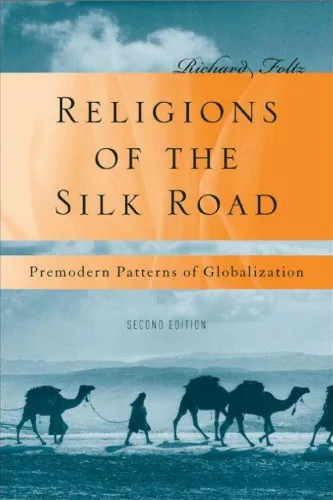Religions of the Silk Road: Premodern Patterns of Globalization
3.8
بر اساس نظر کاربران

شما میتونید سوالاتتون در باره کتاب رو از هوش مصنوعیش بعد از ورود بپرسید
هر دانلود یا پرسش از هوش مصنوعی 2 امتیاز لازم دارد، برای بدست آوردن امتیاز رایگان، به صفحه ی راهنمای امتیازات سر بزنید و یک سری کار ارزشمند انجام بدینکتاب های مرتبط:
معرفی کتاب "Religions of the Silk Road: Premodern Patterns of Globalization"
کتاب "Religions of the Silk Road: Premodern Patterns of Globalization" نوشته ریچارد فولتز به بررسی نقش مهم و گسترده جاده ابریشم به عنوان مسیری برای تبادل فرهنگی و دینی در تاریخ میپردازد. این کتاب با نگاهی عمیق به روابط بین شش دین بزرگ منطقه از جمله بودیسم، زرتشتیگری، مسیحیت، اسلام، هندوییسم و یهودیت میپردازد و چگونگی شکلگیری هویتهای دینی و فرهنگی را در این مسیر تاریخی تحلیل میکند.
خلاصهای جامع از کتاب
در این بخش کتاب، نویسنده با استفاده از رویکردی میانرشتهای به بررسی تاریخچه جاده ابریشم و تأثیر آن بر تحولات دینی و اجتماعی میپردازد. فولتز استدلال میکند که جاده ابریشم نه تنها مسیری برای تجارت کالاها بود، بلکه به عنوان یکی از نخستین نمونههای فرآیند جهانی شدن عمل میکرد و روابط پیچیدهای از تبادل فرهنگی و دینی تشکیل میداد. هر فصلی از کتاب به تحلیل یکی از ادیان اصلی و تعاملات آن با سایر فرهنگها در امتداد این مسیر میپردازد.
نکات کلیدی کتاب
- نقش استراتژیک جاده ابریشم در ترویج و تحول ادیان مختلف.
- تأثیر تبادلات فرهنگی و تجاری بر تحولات دینی و اجتماعی.
- تشریح چگونگی فراگیری و گسترش آموزههای دینی در طول جاده ابریشم.
- بررسی تعارضات و تعاملات میان ادیان مختلف و تأثیر آنها بر جامعههای محلی.
جملات معروف از کتاب
"جاده ابریشم نه تنها نقشی اقتصادی داشت، بلکه مسیری برای انتقال ایدهها و باورها نیز بود."
"تبادلات فرهنگی در جاده ابریشم نمونهای از جهانی شدن پیش از مدرنیت است."
چرا این کتاب مهم است؟
این کتاب به سبب رویکرد چندوجهی و تحلیلگرایانهاش در بررسی دوران طلایی جاده ابریشم و برجستگیهای دینی و فرهنگی آن، از اهمیت زیادی برخوردار است. فولتز با ترکیب دادههای تاریخی با تحلیلهای میانرشتهای، توانسته است تصویری دقیق و گسترده از چگونگی تعاملات فرهنگی و دینی در یکی از پرتنشترین و متنوعترین مناطق جهان ارائه کند. خواندن این کتاب به پژوهشگران تاریخ، دین و فرهنگ توصیه میشود، زیرا دیدگاهی نوین از فرایند جهانی شدن در دوران پیش از مدرن ارائه میدهد که بسیار آموزنده و چشمنواز است.
Welcome to an enriched journey through the historical tapestry of cultural and religious exchanges that occurred along the ancient trade routes known as the Silk Road. In "Religions of the Silk Road: Premodern Patterns of Globalization," Richard Foltz offers a comprehensive examination of the dynamic interaction and diffusion of religious ideas across Asia, effectively tracing the footprints of globalization before it became a modern concept.
Detailed Summary of the Book
The book intricately navigates through the vast and complex network of trade routes that connected the East and the West, highlighting the significant role these routes played in the dissemination of religions and the formation of cultural identities. Foltz delves into the spread of major religious traditions such as Zoroastrianism, Buddhism, Christianity, Manichaeism, and Islam, demonstrating how these belief systems were influenced by and in turn influenced the peoples and cultures they encountered along the Silk Road.
Beginning with the earliest trade exchanges, the book traverses through the evolution of these religious landscapes, analyzing how trade facilitated not just economic transactions but also the exchange of ideologies and spiritual knowledge. The narrative covers a period from antiquity to the pre-modern era, examining how religions adapted to new environments and interacted with local customs and beliefs to create the rich tapestry of spiritual diversity we see today.
Key Takeaways
- Religious diffusion along the Silk Road was driven by the movement of traders, missionaries, and pilgrims, who often traveled alongside merchants.
- The exchange of ideas along these routes contributed to a syncretism of beliefs, showcasing humanity's innate ability to adapt and integrate different worldviews.
- By viewing globalization through the lens of religion, we can gain new insights into cultural exchange and the transformational power of ideas over economic and political influences.
- Foltz emphasizes that the Silk Road was not merely a conduit for goods, but a thriving artery for cultural and religious vitality.
Famous Quotes from the Book
"The Silk Road was not a single path, but a myriad of intertwining routes with countless nodal points of convergence and divergence."
"In the ancient world, religion traveled alongside commerce, bringing with it new ideas and fostering a spirit of tolerance and coexistence."
Why This Book Matters
This book sheds light on an often-overlooked aspect of globalization, providing a historical context that enriches our understanding of current global interactions. Richard Foltz's interdisciplinary approach combines history, religious studies, and cultural analysis, making the book an invaluable resource for students, scholars, and anyone interested in the interconnectedness of human societies. By exploring the intricate network of the Silk Road, the book underscores the importance of cultural and religious dialogues that predate modern globalization, echoing the continuous human pursuit of shared knowledge and understanding.
In today's increasingly interconnected world, understanding the historical patterns of cultural exchange can offer crucial perspectives on contemporary issues of multiculturalism and religious pluralism. "Religions of the Silk Road" serves as an essential text for comprehending the roots of globalization and the timeless human quest for meaning across cultural boundaries.
دانلود رایگان مستقیم
شما میتونید سوالاتتون در باره کتاب رو از هوش مصنوعیش بعد از ورود بپرسید
دسترسی به کتابها از طریق پلتفرمهای قانونی و کتابخانههای عمومی نه تنها از حقوق نویسندگان و ناشران حمایت میکند، بلکه به پایداری فرهنگ کتابخوانی نیز کمک میرساند. پیش از دانلود، لحظهای به بررسی این گزینهها فکر کنید.
این کتاب رو در پلتفرم های دیگه ببینید
WorldCat به شما کمک میکنه تا کتاب ها رو در کتابخانه های سراسر دنیا پیدا کنید
امتیازها، نظرات تخصصی و صحبت ها درباره کتاب را در Goodreads ببینید
کتابهای کمیاب یا دست دوم را در AbeBooks پیدا کنید و بخرید
1270
بازدید3.8
امتیاز50
نظر98%
رضایتنظرات:
3.8
بر اساس 0 نظر کاربران
"کیفیت چاپ عالی بود، خیلی راضیام"
Questions & Answers
Ask questions about this book or help others by answering
No questions yet. Be the first to ask!



